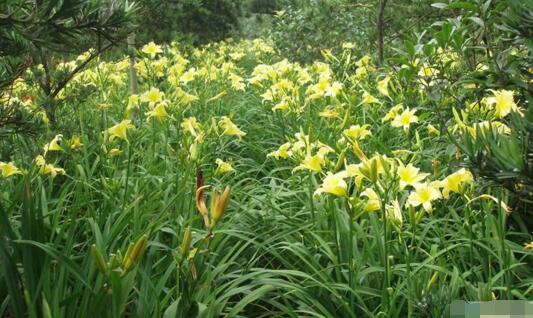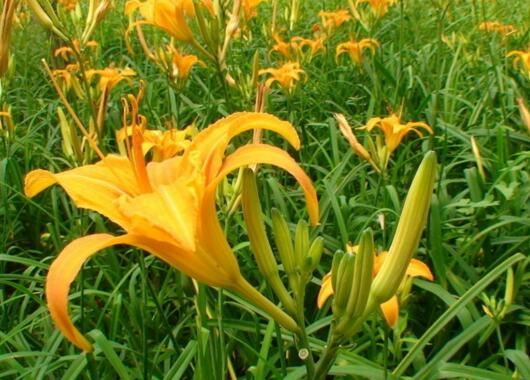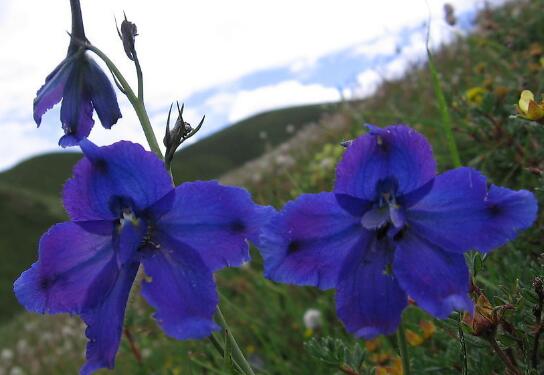How to water Hemerocallis, five techniques to make Hemerocallis grow well
When raising a lot of plants, we need reasonable watering, of course, when we plant day lilies, too little watering will make the plants thin and grow slowly, and too much watering will cause rotten roots, so how to water day lilies? The editor will tell you the answer.
How to water Hemerocallis
1. After germination in spring

2-year-old day lilies sprout in spring, and when the buds grow, it is necessary to ensure enough water, otherwise it will affect the delay of flowering, so it is common to water once every 7-10 days after spring, depending on the wetness of the soil.
2. Before flowering
Watering can be reduced appropriately before flowering, and if the climate is not too dry, the soil can be kept dry, but in order to avoid soil consolidation, water should be watered every 10 days or so.
3. When in bloom
You can stop watering after flowering, and there is no need to spray water on the flowers and leaves. Some flower friends like to spray water on the plants in order to improve the beauty of the flowers, which is wrong.
4. After the flowers fade
How to water the day lilies after the flowers fade? Watering can begin 10 days after withering, which is the same as during the growing period, about once a week, based on the principle of keeping the soil moist, and watering can be reduced or even not watered at the end of autumn.
5. Winter
It is generally not watered in winter, when the temperature is lower, and Rain Water is more abundant, the soil contains enough water to survive the winter smoothly, watering will cause adverse effects.
Points for attention in watering
1. Not too much
When watering to avoid too much water, if too much water, the soil will be too wet, the root will also appear waterlogging, resulting in external air can not enter the soil, Hemerocallis root respiration is affected, thus affecting the normal development.
2. Water should be clean
For Hemerocallis hemerocallis, the water quality must be clean, can be irrigated with domestic tap water, and do not use waste water to water Hemerocallis, so as to avoid germs in the water to pollute the soil, so that Hemerocallis is attacked by diseases and insect pests.
How to raise day lilies, the culture methods and matters needing attention / suitable exploding pot of day lilies
Because the efficacy and function of day lilies are very many, so there are many people who raise it. It is cultivated in many places in China, and it can even be wild, but if you want to raise it well, you still need certain skills and methods. So how to raise day lilies? Let's take a look at the breeding methods and points for attention of Hemerocallis.
Growth environment of Hemerocallis
Before we know how to raise day lilies, we need to know what kind of environment it likes. Day lilies like humus-rich, well-drained soil and moist and warm environment, but they are highly adaptable, drought-resistant, cold-resistant and semi-shade-resistant, so they are planted in both the north and the south.
How to raise Hemerocallis
1. Soil
Although Hemerocallis does not have high requirements for soil, in order to make its growth more robust, the soil should be sandy soil with more humus, loose, good drainage and permeability, and can be made of rotten leaf soil, garden soil and river sand if there are conditions.
2. Temperature
Hemerocallis is relatively cold-resistant and heat-resistant, it can also survive the winter smoothly in the open field in North China, it can be seen its ability to adapt to temperature, but in the environment of 15-25 degrees, its growth is the fastest, so if you want it to grow well, it is best to control the temperature at about 20 degrees.
3. Lighting
Day lilies like the sun and can grow normally in a semi-shady environment, so if conditions permit, they can be kept in full light or managed in a ventilated and semi-overcast place.
4. Fertilization
Topdressing begins in the second year after planting, the first time is when the new bud grows to about 10 cm, the second time is when the scape is trimmed, and the third time is before flowering, fertilization is mainly liquid fertilizer, which can promote its growth and flowering, so fertilization is very important in the breeding methods and matters needing attention of Hemerocallis.
5. Watering
Day lilies are more drought-resistant, but they prefer humid environments, so they can be watered by climate change during the growing season, less watering or no watering in the rainy season, and watering every 3-5 days in summer to prevent the soil from being too dry.
6. Prevention of diseases and insect pests
The common diseases of Hemerocallis are leaf spot, leaf blight, rust and so on, and the common pests are red spiders, aphids and so on. Keeping the environment clean, tidy and ventilated, and timely fertilization to improve its resistance to diseases and insect pests can play a good preventive effect.
Matters needing attention in Hemerocallis Culture
1. When watering, do not let waterlogging appear in the soil. If so, check whether the drainage of the soil is good, and eliminate the waterlogging in time. Pay attention to the soil wetting in the rainy season and avoid soaking in the water for a long time.
2. Before remanufacturing, the soil should be disinfected. Potassium permanganate can be used to irrigate the soil, or it can be dried in the sun for a few days to ensure that it is free of germs and eggs.
3. Before flowering, we can mainly supplement phosphorus and potassium fertilizer, and at the same time, 0.2% potassium dihydrogen phosphate can be sprayed, which can make the flowers more colorful, larger and prolong the flowering period.
How to raise Hemerocallis to explode
In addition to doing well the above points, if you want to make Hemerocallis burst, it should also be pruned in time, because the root system of Hemerocallis has a tendency to move upward to the surface year by year, so it should be pruned in combination with soil cultivation, and at the same time, the flower stem should be cut off after the flower fade to avoid nutrient loss.
Culture methods of Hemerocallis vulgaris
Hemerocallis grows in forests, wetlands, meadows or grasslands at lower elevations. It has strong cold resistance, sufficient light resistance and semi-shade resistance, and is not strict with the soil, but the permeable soil with high humus content and good drainage is better. Fertilizers are often applied during the growing season. In the north, the underground tubers should be dug up before frost and stored in an environment with a temperature of about 5 ℃. Because of its large and colorful flowers, rich colors, good plant shape, easy cultivation. The optimum temperature for open field cultivation is 13-17 ℃.
Ramet division of hemerocallis is the most commonly used method of propagation. The operation of this method is simple, the plant is easy to survive and the growth is consistent. Ramet can dig out all the mother plant cluster and replant it, or dig out a part of the plant from one side of the mother plant cluster to make seedlings, leaving behind to continue to grow.
Ramets are mostly carried out before sprouting in spring or after defoliation in autumn. When the ramets are transplanted in spring, they can bolt and blossom in the same year, and in autumn, they can sprout and blossom the following year. Plants with exuberant growth, many buds, good quality and free from diseases and insect pests should be selected when transplanting.
When ramet, dig a part of the tiller of the plant clump as the seedling, dig the part with root, cut it from the shortened stem, cut off the old root, rotten root and diseased root, retain the fleshy root as far as possible, cut it short properly (about 10 cm) and then plant it. Planting should be carried out in sunny days, while digging seedlings, while dividing seedlings, while planting seedlings, as little as possible to hurt roots, so slow seedlings fast. Generally, the plant is divided once every 2 to 3 years to ensure the exuberant growth of the plant.
- Prev

How to raise day lilies, the culture methods and matters needing attention / suitable exploding pot of day lilies
Because the efficacy and function of day lilies are very many, so there are many people who raise it. It is cultivated in many places in China, and it can even be wild, but if you want to raise it well, you still need certain skills and methods. So how to raise day lilies? Let's take a look at the culture methods and matters needing attention of Hemerocallis.
- Next

How to cultivate delphinium, cultivation methods and precautions of delphinium/sufficient light
Delphinium is a kind of ornamental flower plant, in our country it is also a lot of people, but when it needs to pay attention to a lot of places, about how to raise delphinium? What are the breeding methods and precautions of delphinium? The following small series takes everyone to understand
Related
- Fuxing push coffee new agricultural production and marketing class: lack of small-scale processing plants
- Jujube rice field leisure farm deep ploughing Yilan for five years to create a space for organic food and play
- Nongyu Farm-A trial of organic papaya for brave women with advanced technology
- Four points for attention in the prevention and control of diseases and insect pests of edible fungi
- How to add nutrient solution to Edible Fungi
- Is there any good way to control edible fungus mites?
- Open Inoculation Technology of Edible Fungi
- Is there any clever way to use fertilizer for edible fungus in winter?
- What agents are used to kill the pathogens of edible fungi in the mushroom shed?
- Rapid drying of Edible Fungi

